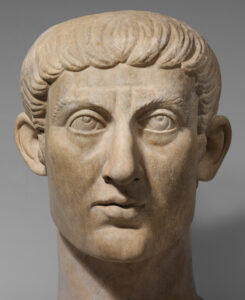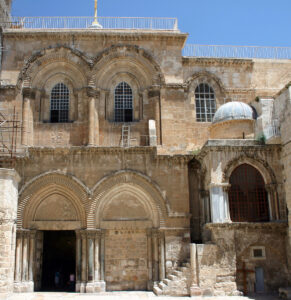By Dr. Don Bierle, FaithSearch President
God, through the prophet Isaiah, stated, “See, I lay a stone in Zion, a tested stone, a precious cornerstone for a sure foundation…” (Isaiah 28:16 NIV). The apostle Peter identified that particular prophecy with Jesus Christ, “And coming to Him as to a living stone, rejected by men, but choice and precious in the sight of God” (1 Peter 2:4-7).

The life and ministry of Jesus in the first century literally changed the world. He also changed individual human lives. The Roman Emperor Constantine (A.D. 306-337) allegedly embraced faith in Jesus, and together with the Edict of Milan in 313 (which granted legal recognition and freedom to Christians), he reversed years of Christian persecution. He even gave preferential treatment to Christianity.
As a result, Constantine, together with his mother, Helena (who also confessed transforming faith in Jesus), set about to have the life and ministry of Jesus commemorated in massive edifices. Perhaps as a result of his attendance at the Council of Nicaea in AD 325, he adopted the truth of the three major events of Jesus’ life mentioned in the Nicene Creed – the incarnation, the passion, and the ascension. Beginning in that year, He initiated construction of the Church of the Nativity in Bethlehem (commemorating Jesus’ birth); the Church of the Holy Sepulchre in Jerusalem (Jesus’ crucifixion, burial, and resurrection); and the Eleona/Church of the Ascension on the Mount of Olives (Jesus’ ascension). Truly the life of Jesus, the Precious Stone, was historically being remembered in stone!
The First and Grandest Commemorative Church

The Church of the Holy Sepulchre in Jerusalem today is from the Crusader period (1096-1279). Constantine’s fourth century original was larger and consisted of an ornate, twelve-column basilica (one for each apostle) called the Martyrium, and an inner courtyard with a spire marking the site of Jesus’ crucifixion (Golgotha). It also had an aedicule containing the original tomb of Jesus which later was covered with the grand rotunda called the Anastasis.
The church Fathers, who succeeded the apostles in the late first and early second centuries, claim to have identified “Golgotha” and Joseph of Arimathea’s nearby tomb (Eusebius). This gave credibility to their historical authenticity. The Church was dedicated on the occasion of Constantine’s tricennalia in 335 (the thirtieth year of his reign) with instruction to the bishop of Jerusalem that it be the “fairest structure in any city of the empire.”
Three Sister Churches

The Church of the Nativity in Bethlehem, the Eleona Church, and the Church of the Ascension followed shortly after the Holy Sepulchre. Helena insisted that the birth and ascension of Jesus be identified by a shrine.
Included in the Church of the Nativity was an octagonal structure built over the cave identified by the church Fathers (Justin Martyr; Origin; Eusebius) as the place of Jesus’ birth. This Roman architecture was usually used to mark the burial site of an important person. In contrast, in this case it marks not a burial but a birth.
Constantine is quoted as ordering that a basilica be built “where the Lord taught before His passion” (a reference to the Olivet Discourse in Matthew 24-25). This Eleona Church has been identified by archaeologists beneath the modern Pater Noster Church, a few hundred feet from the Church of the Ascension, which has been located beneath a medieval Islamic shrine at the summit of the Olivet mount (Luke 24:50-51; Acts 1:6-12). These two churches may have formed a single complex on the Mount of Olives.
More Testimony in Stone

Besides the Jerusalem churches, Constantine sent out an imperial decree that “life-of-Jesus” monuments should be built in the Galilee as well, with the cities of Nazareth, Tiberius, Bethsaida, and Capernaum being named. An example is the Church of the Anunciation in Nazareth, which marks the site where the angel Gabriel announced the conception of Jesus to Mary. The Chapel of the Beatitudes and the Church of the Multiplication are other examples. Unfortunately, some of the Galilean commemorative churches have never been found by archaeologists, but those found date to the fourth century, during the reign of Constantine.
Jesus: The Historical God-Man
The take-away here is the documentation of the historicity of Jesus. Given this evidence and more, no one can possibly deny that Jesus lived in Israel in the first century. Furthermore, His life was like no other. He was also Divine. His teaching and miracles transformed thousands of people. His sacrificial death on the cross was redemptive for humanity from sin and death. Without Him, a hole is left in human civilization that no-one and nothing else can fill. As the apostle Paul wrote,
But when the fullness of the time had come, God sent forth His Son, born of a woman, born under the law, to redeem those who were under the law, that we might receive the adoption as sons (Galatians 4:4-5, NKJV).
A precious Stone indeed!
Source: “The Life of Jesus Written in Stone.” Jordan J. Ryan, Biblical Archaeology Review, Winter 2024, pp. 41-49.



